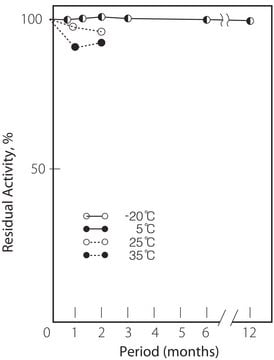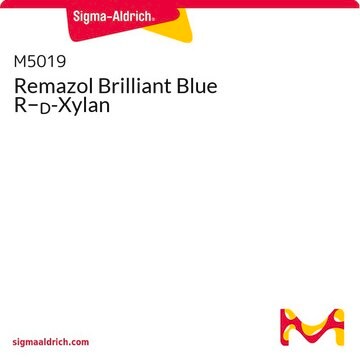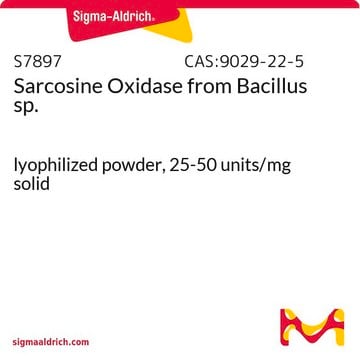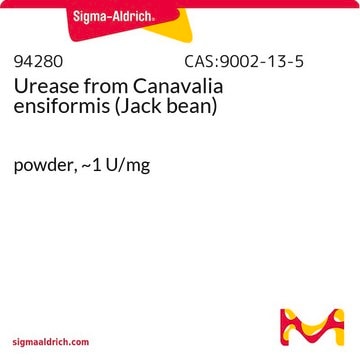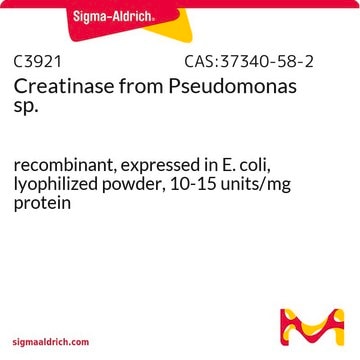C9409
Creatinine Deiminase microbial
lyophilized powder, ≥25 units/mg protein
Synonyme(s) :
Creatinine Deaminase
Se connecterpour consulter vos tarifs contractuels et ceux de votre entreprise/organisme
About This Item
Numéro CAS:
Numéro CE :
Numéro MDL:
Code UNSPSC :
12352204
Nomenclature NACRES :
NA.54
Produits recommandés
Forme
lyophilized powder
Activité spécifique
≥25 units/mg protein
Poids mol.
~260 kDa
Composition
Protein, ≥15% biuret
Température de stockage
−20°C
Application
Creatinine Deiminase microbial has been used:
- to immobilize aminosilylated glass beads based biosensor for ammonia/ammonium and creatinine detection in urine
- in creating creatinine-sensing membrane for biophysical studies
- to investigate the bioelectronic tongue for the simultaneous determination of urea, creatinine and alkaline ions in clinical samples
Creatinine deiminase has been used in a study to assess the application of a creatinine-sensitive biosensor for hemodialysis control. Creatinine deiminase has also been used in a study to investigate the bioelectronic tongue for the simultaneous determination of urea, creatinine and alkaline ions in clinical samples.
Actions biochimiques/physiologiques
Creatinine deiminase catalyzes the hydrolysis of creatinine to methylhydantoine and ammonia.
Propriétés physiques
Isoelectric point : 4.4
Michaelis constant : 3.5 x 10‾3M (Creatinine)
Structure : 6 subunits per mol of enzyme
Inhibitors : Ag+,Hg++, o-phenanthroline,monoiodoacetate
Optimum pH : 8.5 – 9.5
Optimum temperature : 65 – 75°C
pH Stability : pH 7.0 – 11.0 (30°C, 20hr)
Thermal stability : Below 65°C (pH 7.5, 1hr)
Michaelis constant : 3.5 x 10‾3M (Creatinine)
Structure : 6 subunits per mol of enzyme
Inhibitors : Ag+,Hg++, o-phenanthroline,monoiodoacetate
Optimum pH : 8.5 – 9.5
Optimum temperature : 65 – 75°C
pH Stability : pH 7.0 – 11.0 (30°C, 20hr)
Thermal stability : Below 65°C (pH 7.5, 1hr)
Définition de l'unité
One unit will hydrolyze 1.0 μmole of creatinine to N-methylhydantoin and NH3 per min at pH 7.5 at 37 °C in a coupled system with L-glutamic dehydrogenase.
Forme physique
Lyophilized powder containing mannitol as stabilizer
Code de la classe de stockage
11 - Combustible Solids
Classe de danger pour l'eau (WGK)
WGK 3
Point d'éclair (°F)
Not applicable
Point d'éclair (°C)
Not applicable
Équipement de protection individuelle
Eyeshields, Gloves, type N95 (US)
Certificats d'analyse (COA)
Recherchez un Certificats d'analyse (COA) en saisissant le numéro de lot du produit. Les numéros de lot figurent sur l'étiquette du produit après les mots "Lot" ou "Batch".
Déjà en possession de ce produit ?
Retrouvez la documentation relative aux produits que vous avez récemment achetés dans la Bibliothèque de documents.
Z K He et al.
Analytical biochemistry, 283(2), 166-174 (2000-07-25)
A precise and sensitive working microflow titration procedure was developed to determine creatinine and ammonia in urine samples. This procedure is based on enzymatic conversion of creatinine, gas diffusional membrane separation of the released ammonia into an acid acceptor stream
Hong Dinh Duong et al.
Sensors (Basel, Switzerland), 17(11) (2017-11-09)
In this study, the oxazine 170 perchlorate (O17)-ethylcellulose (EC) membrane was successfully exploited for the fabrication of creatine- and creatinine-sensing membranes. The sensing membrane exhibited a double layer of O17-EC membrane and a layer of enzyme(s) entrapped in the EC
Manuel Gutiérrez et al.
Biosensors & bioelectronics, 23(6), 795-802 (2007-10-13)
Urea and creatinine biosensors based on urease and creatinine deiminase, respectively, covalently immobilized onto ammonium selective electrodes, were included in an array together with sensors sensitive to ammonium, potassium and sodium. Generic sensors to alkaline ions were also included. All
R G Washburn et al.
The Journal of antimicrobial chemotherapy, 17(5), 673-677 (1986-05-01)
Creatinine iminohydrolase (EC 3.5.4.21) quantitatively releases ammonia from flucytosine (5FC) as well as from creatinine. Using 39 sera from eight patients receiving the combination of amphotericin B with 5FC, we demonstrated that this rapid enzymatic reaction provides a valid measure
C M Huang et al.
Clinical chemistry, 34(1), 59-62 (1988-01-01)
We developed an enzymatic method for determination of 5-fluorocytosine in serum, using creatine iminohydrolase (EC 3.5.4.21), the Cobas-Bio analyzer, and an extant ammonia method. Analytical recovery (y) of drug added to serum (x) was good, with y = 0.97x-0.7, Sy.x
Notre équipe de scientifiques dispose d'une expérience dans tous les secteurs de la recherche, notamment en sciences de la vie, science des matériaux, synthèse chimique, chromatographie, analyse et dans de nombreux autres domaines..
Contacter notre Service technique